Daily News
by Gail Helmer
[ Send Us News | Archives ]
New Screens: Mobile Forces
Rage has sent us eight new screens from the upcoming vehicular combat and first-person shooting, Mobile Forces.. [More...]
New Screens: Rainbow Six: Raven Shield
We have just received 4 new screens from the newest installment in the Rainbow Six series, Raven Shield. [More...]
Operation Flashpoint Ultimate Upgrade 4
Operation Flashpoint: Cold War Crisis is now available to bring this version to 1.46. This release fixes eight minor bugs, and as expected there's also an updated dedicated server.Read me, Download
Rainbow Six: Raven Shield Announced
Ubi Soft Entertainment today announced plans to develop and publish the next installment of the best-selling Rainbow Six series of games with Tom Clancy's Rainbow Six: Raven Shield. Ubi Soft will release Rainbow Six: Raven Shield on both the PC and the Xbox video game system in the fall of 2002.
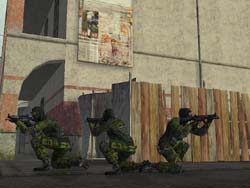
Rainbow Six: Raven Shield features a brand new Tom Clancy storyline in which Team RAINBOW is led all over the world in a string of dramatic operations. The game will utilize graphics technology provided by the next-generation Unreal engine to power 15 new single-player missions that include the discovery of a cache of biological weapons and stopping an armed gang from terrorizing a London bank.
Space Empires: IV Gold Ships
Shrapnel Games is proud to announce that the latest game from Malfador Machinations, Space Empires: IV Gold, has shipped.
Mobile Forces Site Launched
Rage Software has launched a new Web site for Mobile Forces, its upcoming action game, which combines vehicular combat and first-person shooting. The new site contains a general overview of the game, a gallery of screenshots and concept images, answers to frequently asked questions, several downloadable wallpaper images, and information about the development team.
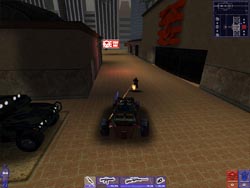
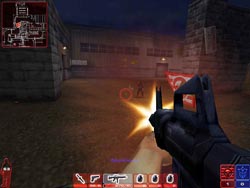
Mobile Forces is powered by the Unreal engine, and it includes eight game modes and 11 realistic environments that range from the Arctic to the Wild West. The game features a variety of vehicles with realistic physics.
Specnaz: Project Wolf Unveiled
Slovakian game developer Byte Software has opened a new official Web site for Specnaz: Project Wolf its upcoming action game. The new site contains a brief description of the game, an overview of the game's storyline and missions, and a gallery of character renders and concept images.
Specnaz: Project Wolf is a first-person shooter set in the years after the fall of the Soviet Union. Since the former Soviet military bases are no longer secure locations, the Russian government has begun a secret program to extract its nuclear weapons from facilities around the world. When a transport carrying the materials goes down, the Russian Special Forces soldiers known as Specnaz are called in to help. The game will include a number of missions set in different locations around the world. In addition, it will include several multiplayer modes, such as deathmatch, squadmatch, capture the nuke, reconnaissance, Specnaz vs. Delta, and atomic countdown.
Gunship! Add-on Announced
A new add-on project for Gunship! has been announced. The add-on will simulate helicopter combat during the Vietnam War. Pretzel is currently building several new helicopters, includung the Huey, Loach, and CH-47A Chinook. Details/discussion click here
Military News
Northrop Grumman To Upgrade BQM-74 Aerial Target
Northrop Grumman Corporation's Integrated Systems sector has been awarded a $24.9 million contract by the U.S. Navy to develop and test the BQM-74F, a significant upgrade of the BQM-74 aerial target that will provide more realistic fleet training against antiship cruise missiles or enemy fighter aircraft.
The contract includes requirements to complete the full system design and development of the BQM-74F system, including kits, support equipment, logistic support and manuals.
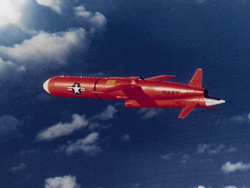
Work on this contract will begin in March 2002, with vehicle first flight scheduled in mid-2004. Final assembly and checkout will be performed in Palmdale, Calif., with engineering design, analysis and integration in San Diego. The BQM-74 program is managed by the Navy's Program Executive Office, Strike Weapons and Unmanned Aviation, and Naval Air Systems Command, Patuxent River, Md.
The Navy will use the BQM-74F to provide more realistic threat simulation to test and evaluate new weapon systems and for fleet training. The BQM-74F is a high subsonic aerial target that will more effectively emulate antiship cruise missiles or enemy fighter aircraft. Compared with the current BQM-74E model, the upgraded target features higher speed, greater maneuverability and increased range and endurance.
Northrop Grumman Receives Contract For AN/ALQ-135
The F-15E fighter will continue receiving superior electronic countermeasures (ECM) protection through a $65 million contract awarded by the U.S. Air Force for 28 AN/ALQ-135 Band 1.5 subsystems to Northrop Grumman Corporation's Defensive Systems Division.
Eleven of the systems have been delivered to Elmendorf Air Force Base, Alaska, for installation. The remainder of the contract, which is the third of a five-lot production program, is to be completed by September 2003. The program is managed by the F-15 Development System Program Office at Wright-Patterson Air Force Base, Ohio.
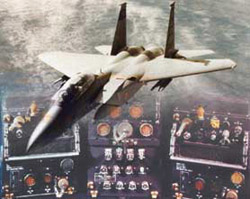
An internally mounted radar countermeasures system designed and developed for the F-15 fleet, the AN/ALQ-135 has been designated by the Air Force as "mission essential" for all combat F-15Es. The AN/ALQ-135 has thousands of hours of combat operations, beginning with Desert Storm and continuing through recent conflicts in the Balkans, Kosovo and Afghanistan without a single aircraft loss due to threats covered by the ECM system.
Northrop Grumman and TRW Locked In Take-Over Struggle
Northrop Grumman has intensified its efforts to acquire TRW in hostile fashion despite a vigorous rejection of its initial offer by TRW's Board of Directors. In a situation of industrial thrust and counter-thrust Northrop Grumman made its stock offer available to individual share-holders of TRW and moved to challenge the strict merger and acquisition laws of Ohio, that may scupper its aggressive intentions. A short time later, a letter from the TRW Board, that dismissed the size of Northrop's bid as "financially inadequate", was made available.
In a Press Release Ken Kresa, CEO of Northrop Grumman, stated: "We have not received a substantive response from TRW regarding our February 21 letter to enter into negotiations for a proposed business combination. Accordingly, we are moving ahead to make this offer available to TRW shareholders and to initiate all the steps that are necessary to see it through to conclusion, including requesting that the TRW board of directors call the special meeting of shareholders required under Ohio law to authorise our acquisition of TRW shares."
A few more hours would have revealed the nature of the response from TRW to his bold approach. The letter from TRW Chairman Philip Odeen and lead director Kenneth Freeman to Kent Kresa read: "We believe Northrop Grumman's proposal grossly undervalues TRW's businesses, including its premier franchise in the defence industry, does not adequately reflect the true value of our unique market position and business opportunities, and is not consistent with our objective of enhancing shareholder value."
It went on to say: "The board views Northrop Grumman's proposal as an opportunistic attempt to acquire one of the industry's leading space and electronics and systems businesses at a time when TRW's stock price was temporarily depressed after the sudden departure of David Cote, our former chairman, president and chief executive officer."
Under Ohio law, TRW now has ten days to set a date for a special shareholder's meeting to vote on the hostile bid. The vote must be held within 60 days of the launch of the tender offer. Northrop Grumman's offer to the shareholders expires on March the 29th.
It remains to be seen what form Northrop's legal challenge to Ohio law will take. However, the state rules in this case would prohibit any investors who support the take-over but acquired their stock in TRW after the initial approach of February 21 from voting at the shareholder meeting. Furthermore, were Northrop Grumman to be successful in their take-over they may have problems in unloading the unwanted auto parts wing of TRW. Companies pursuing hostile bids in Ohio face a three-year moratorium on selling off the target company's assets to help reduce debt. TRW has significant debts.
United Defense's Crusader Meets Milestone B Firing Requirements
The Crusader Self-Propelled Howitzer One (SPH1) prototype has set a new one-day record of 176 rounds fired and successfully met and exceeded the Army's rate of fire and Multiple Round Simultaneous Impact (MRSI) firing exit criteria for Milestone B, due in April 2003. In all, 935 rounds were fired in February establishing a new high for total rounds fired in a month.
"These achievements tell us we are on target," said Jim Unterseher, programme director for Crusader at United Defense, the prime contractor. "We have a lot to do for a successful Milestone B, but this is a great step forward."
To meet the Milestone B rate of fire objective, Crusader fired 15 round missions at ranges of 10,15,25 and 30 kilometres at a rate of fire greater than 9 rounds per minute. Crusader exceeded the milestone requirement by over 3 rounds per minute. To meet the MRSI mission objective, Crusader fired six four-round missions where all rounds impacted within plus or minus 2 seconds of each other at a range of 17 kilometres. Crusader is not only exceeding the Milestone B exit criterion of plus or minus 4 seconds, it is meeting the objective performance requirement. The Crusader successfully repeated the MRSI mission several times, at ranges of 8, 25 and 30 kilometres.

"The Army is very pleased with Crusader's progress," said Col. Russell Hrdy, US Army project manager for Crusader. "Secretary White recently told Congress that 'Crusader will provide combat overmatch to our commanders until at least 2032 and serve as a technology carrier to the Objective Force.' Being on time and on target ensures that goal."
Crusader will continue to conduct testing of the armament system and anticipates firing over 10,000 rounds through the Programme Definition and Risk Reduction (PDRR) phase. The weapon system has now fired over 5,400 rounds at Yuma Proving Ground.
Crusader has met its full maximum range requirement of 40 kilometres and fired both live and inert projectiles within all of its required target zones from seven to 40 kilometres. It has demonstrated a maximum rate of fire of 11.1 rounds per minute.
Crusader will enter the System Design and Development (SD&D) phase in April 2003.
The self-propelled 155-mm howitzer (SPH) is supported by tracked and wheeled resupply vehicles. Two Crusader vehicles will be strategically deployable by C-17 aircraft.
JSF-F136 Team Keep Engine Tests On Target For Full Development
The JSF-F136 Engine Team, now on contract for the US Joint Strike Fighter Programme, is involved in full-scale engine design and development work that will lead to full engine testing in 2004. The team, which consists of GE Aircraft Engines (GEAE) and Rolls-Royce (R-R), completed the analytical work that confirms the range and thrust parameters for the engine earlier this year.
The engine's three-stage fan, designed by R-R, has reached full speed and pressure ratio while meeting its performance targets. In addition, the engine's core, designed by GEAE and R-R, accumulated over 75 hours of in 2000, achieving all of the performance objectives.
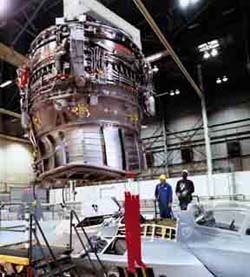
The core engine testing was the centrepiece of the programme's four-year Phase II, awarded in 1996, which also involved the Critical Design Review and several component rig tests. Phase III, a $460 million contract which runs through 2005, will involve component and subsystem testing, leading to full JSF-F136 engine testing in 2004.
In Phase III, JSF-F136 engines will be tested for the various JSF variants: Short Take-Off Vertical Landing (STOVL) for the US Marine Corps and U.K. Royal Navy, Conventional Take-Off/Landing (CTOL) for the US Air Force, and the Carrier Variant (CV) for the US Navy.
For the JSF-F136, GEAE is developing advanced core-compressor and turbine-system components. GEAE and R-R are jointly developing an integrated high-pressure/low-pressure counter-rotating turbine design, while R-R is responsible for the combustor/diffuser system, gearboxes, and an advanced high-pressure-ratio, long-chord, hollow, titanium blisk fan. The JSF-F136 incorporates technology and processes from the highly successful IHPTET (Integrated High Performance Turbine Engine Technology) programmes.
Lockheed Martin Moves Ahead On F-22 Raptor Production
Lockheed Martin Aeronautics led F-22 Raptor industry team has received a $215.3 million contract from the US Air Force to purchase long-lead items necessary for the fabrication and assembly of 23 additional fighters during production Lot 3. Earlier this month, the Bush administration requested funding from Congress to purchase those 23 aircraft as part of the fiscal 2003-defence budget. The Pentagon announced this contract on Feb. 15.
"Long-lead items are aircraft components that have lengthy raw material lead times, or require extensive fabrication time due to their complexity," Bob Rearden, F-22 programme vice president and general manager, said. "As a result, orders for such items are placed far in advance of their delivery dates to ensure timely arrival when needed during the aircraft's assembly phase."
Long-lead items to be purchased under this contract include bulk titanium, landing gear components, cockpit canopy transparencies, and composite pivot shafts used to attach the aircraft's horizontal stabilisers to the Raptor's tail assembly.
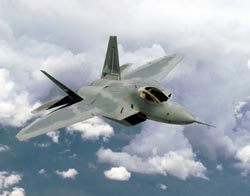
The aircraft purchase is subject to congressional ratification of the appropriations necessary to build the 23 planes. The Raptors (tail numbers 4041 through 4067) are scheduled for delivery by the end of 2005. The Raptor is designed to replace the ageing F-15 Eagle starting in 2005.
Team Raptor is currently working under two previous production contracts to build 23 F-22s. In addition, nine test aircraft have already been built to support the programme's Engineering and Manufacturing Development (EMD) phase. Eight more Production Representative Test Vehicles (PRTVs) are also in various stages of fabrication and assembly, and will be used for operational test and evaluation, starting next year.
Lockheed Martin Receives Multi-Year F-16 Support Contract
Lockheed Martin Aeronautics has been awarded an approximately $69 million post-production support contract to support the world-wide F-16 fleet. The programme, named Falcon 2020, reflects the fact the F-16 will be in the inventory of the US Air Force and international air forces well beyond the year 2020 and the commitment to fully support the aircraft over its service life. The programme was designed to enhance the F-16's combat capability, readiness and sustainability.
The contract, a renewable multi-year contracting arrangement with actual amounts depending on needs of the customers and funding available, provides for engineering services and technical support, repair and return, contractor support, acquisition development and integration, and supplies in support of the F-16 weapon system. This new multi-year contract arrangement includes more flexible terms and conditions that make it easier for the US government to contract with Lockheed Martin for support of the F-16 on an annual basis.
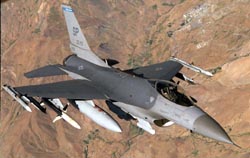
"This new long-term contracting arrangement will allow the US Air Force and other international customers a more cost-effective contracting method for sustaining their F-16 fleets. It reflects a long-term commitment on the part of both the US government and Lockheed Martin for F-16 fleet support and upgrade for the next two decades and beyond," said John L. Bean, vice president of F-16 Programmes for Lockheed Martin Aeronautics Company.
The value of the orders on the contract is approximately $69 million. According to the US Department of Defense, the estimated potential value is approximately $12.7 billion over a 23-year period.
The Falcon 2020 programme is a Department of Defense acquisition reform initiative that was conceived in 1994 and was first contracted in 1997. It was a five-year renewable contract. The programme grew from the initial seven countries to the current 17 participating countries. Three new features of the new Falcon 2020 contract are repair and return of major components, acquisition of modification kits (including future major capability upgrades), and on-site contractor support.
The 17 countries who have participated in the Falcon 2020 programme include: Belgium, Denmark, the Netherlands, Norway, Bahrain, Egypt, Greece, Israel, Jordan, Korea, Portugal, Singapore, Taiwan, Thailand, Turkey, Venezuela and the United States. This programme will be available to new F-16 customers as well.
The F-16, the world's most sought-after fighter, is the choice of 22 countries. More than 4,000 aircraft have been delivered, hundreds more are on order for the US, and six other countries, and production is expected to continue beyond 2010. Major upgrades for all F-16 versions are being incorporated to keep the fleet modern and fully supportable over the aircraft's long service life.
[ Send Us News | Archives ]
by Gail Helmer
Monday March 04, 2002
- New Screens: Mobile Forces
- New Screens: Rainbow Six: Raven Shield
- Operation Flashpoint Ultimate Upgrade 4
- Rainbow Six: Raven Shield Announced
- Space Empires: IV Gold Ships
- Mobile Forces Site Launched
- Specnaz: Project Wolf Unveiled
- Gunship! Add-on Released
- Northrop Grumman To Upgrade BQM-74 Aerial Target
- Northrop Grumman Receives Contract For AN/ALQ-135
- Northrop Grumman and TRW Locked In Take-Over Struggle
- United Defense's Crusader Meets Milestone B Firing Requirements
- JSF-F136 Team Keep Engine Tests On Target For Full Development
- Lockheed Martin Moves Ahead On F-22 Raptor Production
- Lockheed Martin Receives Multi-Year F-16 Support Contract
New Screens: Mobile Forces
Rage has sent us eight new screens from the upcoming vehicular combat and first-person shooting, Mobile Forces.. [More...]
New Screens: Rainbow Six: Raven Shield
We have just received 4 new screens from the newest installment in the Rainbow Six series, Raven Shield. [More...]
Operation Flashpoint Ultimate Upgrade 4
Operation Flashpoint: Cold War Crisis is now available to bring this version to 1.46. This release fixes eight minor bugs, and as expected there's also an updated dedicated server.Read me, Download
Rainbow Six: Raven Shield Announced
Ubi Soft Entertainment today announced plans to develop and publish the next installment of the best-selling Rainbow Six series of games with Tom Clancy's Rainbow Six: Raven Shield. Ubi Soft will release Rainbow Six: Raven Shield on both the PC and the Xbox video game system in the fall of 2002.

Rainbow Six: Raven Shield features a brand new Tom Clancy storyline in which Team RAINBOW is led all over the world in a string of dramatic operations. The game will utilize graphics technology provided by the next-generation Unreal engine to power 15 new single-player missions that include the discovery of a cache of biological weapons and stopping an armed gang from terrorizing a London bank.
Space Empires: IV Gold Ships
Shrapnel Games is proud to announce that the latest game from Malfador Machinations, Space Empires: IV Gold, has shipped.
Mobile Forces Site Launched
Rage Software has launched a new Web site for Mobile Forces, its upcoming action game, which combines vehicular combat and first-person shooting. The new site contains a general overview of the game, a gallery of screenshots and concept images, answers to frequently asked questions, several downloadable wallpaper images, and information about the development team.


Mobile Forces is powered by the Unreal engine, and it includes eight game modes and 11 realistic environments that range from the Arctic to the Wild West. The game features a variety of vehicles with realistic physics.
Specnaz: Project Wolf Unveiled
Slovakian game developer Byte Software has opened a new official Web site for Specnaz: Project Wolf its upcoming action game. The new site contains a brief description of the game, an overview of the game's storyline and missions, and a gallery of character renders and concept images.
Specnaz: Project Wolf is a first-person shooter set in the years after the fall of the Soviet Union. Since the former Soviet military bases are no longer secure locations, the Russian government has begun a secret program to extract its nuclear weapons from facilities around the world. When a transport carrying the materials goes down, the Russian Special Forces soldiers known as Specnaz are called in to help. The game will include a number of missions set in different locations around the world. In addition, it will include several multiplayer modes, such as deathmatch, squadmatch, capture the nuke, reconnaissance, Specnaz vs. Delta, and atomic countdown.
Gunship! Add-on Announced
A new add-on project for Gunship! has been announced. The add-on will simulate helicopter combat during the Vietnam War. Pretzel is currently building several new helicopters, includung the Huey, Loach, and CH-47A Chinook. Details/discussion click here
Military News
Northrop Grumman To Upgrade BQM-74 Aerial Target
Northrop Grumman Corporation's Integrated Systems sector has been awarded a $24.9 million contract by the U.S. Navy to develop and test the BQM-74F, a significant upgrade of the BQM-74 aerial target that will provide more realistic fleet training against antiship cruise missiles or enemy fighter aircraft.
The contract includes requirements to complete the full system design and development of the BQM-74F system, including kits, support equipment, logistic support and manuals.

Work on this contract will begin in March 2002, with vehicle first flight scheduled in mid-2004. Final assembly and checkout will be performed in Palmdale, Calif., with engineering design, analysis and integration in San Diego. The BQM-74 program is managed by the Navy's Program Executive Office, Strike Weapons and Unmanned Aviation, and Naval Air Systems Command, Patuxent River, Md.
The Navy will use the BQM-74F to provide more realistic threat simulation to test and evaluate new weapon systems and for fleet training. The BQM-74F is a high subsonic aerial target that will more effectively emulate antiship cruise missiles or enemy fighter aircraft. Compared with the current BQM-74E model, the upgraded target features higher speed, greater maneuverability and increased range and endurance.
Northrop Grumman Receives Contract For AN/ALQ-135
The F-15E fighter will continue receiving superior electronic countermeasures (ECM) protection through a $65 million contract awarded by the U.S. Air Force for 28 AN/ALQ-135 Band 1.5 subsystems to Northrop Grumman Corporation's Defensive Systems Division.
Eleven of the systems have been delivered to Elmendorf Air Force Base, Alaska, for installation. The remainder of the contract, which is the third of a five-lot production program, is to be completed by September 2003. The program is managed by the F-15 Development System Program Office at Wright-Patterson Air Force Base, Ohio.

An internally mounted radar countermeasures system designed and developed for the F-15 fleet, the AN/ALQ-135 has been designated by the Air Force as "mission essential" for all combat F-15Es. The AN/ALQ-135 has thousands of hours of combat operations, beginning with Desert Storm and continuing through recent conflicts in the Balkans, Kosovo and Afghanistan without a single aircraft loss due to threats covered by the ECM system.
Northrop Grumman and TRW Locked In Take-Over Struggle
Northrop Grumman has intensified its efforts to acquire TRW in hostile fashion despite a vigorous rejection of its initial offer by TRW's Board of Directors. In a situation of industrial thrust and counter-thrust Northrop Grumman made its stock offer available to individual share-holders of TRW and moved to challenge the strict merger and acquisition laws of Ohio, that may scupper its aggressive intentions. A short time later, a letter from the TRW Board, that dismissed the size of Northrop's bid as "financially inadequate", was made available.
In a Press Release Ken Kresa, CEO of Northrop Grumman, stated: "We have not received a substantive response from TRW regarding our February 21 letter to enter into negotiations for a proposed business combination. Accordingly, we are moving ahead to make this offer available to TRW shareholders and to initiate all the steps that are necessary to see it through to conclusion, including requesting that the TRW board of directors call the special meeting of shareholders required under Ohio law to authorise our acquisition of TRW shares."
A few more hours would have revealed the nature of the response from TRW to his bold approach. The letter from TRW Chairman Philip Odeen and lead director Kenneth Freeman to Kent Kresa read: "We believe Northrop Grumman's proposal grossly undervalues TRW's businesses, including its premier franchise in the defence industry, does not adequately reflect the true value of our unique market position and business opportunities, and is not consistent with our objective of enhancing shareholder value."
It went on to say: "The board views Northrop Grumman's proposal as an opportunistic attempt to acquire one of the industry's leading space and electronics and systems businesses at a time when TRW's stock price was temporarily depressed after the sudden departure of David Cote, our former chairman, president and chief executive officer."
Under Ohio law, TRW now has ten days to set a date for a special shareholder's meeting to vote on the hostile bid. The vote must be held within 60 days of the launch of the tender offer. Northrop Grumman's offer to the shareholders expires on March the 29th.
It remains to be seen what form Northrop's legal challenge to Ohio law will take. However, the state rules in this case would prohibit any investors who support the take-over but acquired their stock in TRW after the initial approach of February 21 from voting at the shareholder meeting. Furthermore, were Northrop Grumman to be successful in their take-over they may have problems in unloading the unwanted auto parts wing of TRW. Companies pursuing hostile bids in Ohio face a three-year moratorium on selling off the target company's assets to help reduce debt. TRW has significant debts.
United Defense's Crusader Meets Milestone B Firing Requirements
The Crusader Self-Propelled Howitzer One (SPH1) prototype has set a new one-day record of 176 rounds fired and successfully met and exceeded the Army's rate of fire and Multiple Round Simultaneous Impact (MRSI) firing exit criteria for Milestone B, due in April 2003. In all, 935 rounds were fired in February establishing a new high for total rounds fired in a month.
"These achievements tell us we are on target," said Jim Unterseher, programme director for Crusader at United Defense, the prime contractor. "We have a lot to do for a successful Milestone B, but this is a great step forward."
To meet the Milestone B rate of fire objective, Crusader fired 15 round missions at ranges of 10,15,25 and 30 kilometres at a rate of fire greater than 9 rounds per minute. Crusader exceeded the milestone requirement by over 3 rounds per minute. To meet the MRSI mission objective, Crusader fired six four-round missions where all rounds impacted within plus or minus 2 seconds of each other at a range of 17 kilometres. Crusader is not only exceeding the Milestone B exit criterion of plus or minus 4 seconds, it is meeting the objective performance requirement. The Crusader successfully repeated the MRSI mission several times, at ranges of 8, 25 and 30 kilometres.

"The Army is very pleased with Crusader's progress," said Col. Russell Hrdy, US Army project manager for Crusader. "Secretary White recently told Congress that 'Crusader will provide combat overmatch to our commanders until at least 2032 and serve as a technology carrier to the Objective Force.' Being on time and on target ensures that goal."
Crusader will continue to conduct testing of the armament system and anticipates firing over 10,000 rounds through the Programme Definition and Risk Reduction (PDRR) phase. The weapon system has now fired over 5,400 rounds at Yuma Proving Ground.
Crusader has met its full maximum range requirement of 40 kilometres and fired both live and inert projectiles within all of its required target zones from seven to 40 kilometres. It has demonstrated a maximum rate of fire of 11.1 rounds per minute.
Crusader will enter the System Design and Development (SD&D) phase in April 2003.
The self-propelled 155-mm howitzer (SPH) is supported by tracked and wheeled resupply vehicles. Two Crusader vehicles will be strategically deployable by C-17 aircraft.
JSF-F136 Team Keep Engine Tests On Target For Full Development
The JSF-F136 Engine Team, now on contract for the US Joint Strike Fighter Programme, is involved in full-scale engine design and development work that will lead to full engine testing in 2004. The team, which consists of GE Aircraft Engines (GEAE) and Rolls-Royce (R-R), completed the analytical work that confirms the range and thrust parameters for the engine earlier this year.
The engine's three-stage fan, designed by R-R, has reached full speed and pressure ratio while meeting its performance targets. In addition, the engine's core, designed by GEAE and R-R, accumulated over 75 hours of in 2000, achieving all of the performance objectives.

The core engine testing was the centrepiece of the programme's four-year Phase II, awarded in 1996, which also involved the Critical Design Review and several component rig tests. Phase III, a $460 million contract which runs through 2005, will involve component and subsystem testing, leading to full JSF-F136 engine testing in 2004.
In Phase III, JSF-F136 engines will be tested for the various JSF variants: Short Take-Off Vertical Landing (STOVL) for the US Marine Corps and U.K. Royal Navy, Conventional Take-Off/Landing (CTOL) for the US Air Force, and the Carrier Variant (CV) for the US Navy.
For the JSF-F136, GEAE is developing advanced core-compressor and turbine-system components. GEAE and R-R are jointly developing an integrated high-pressure/low-pressure counter-rotating turbine design, while R-R is responsible for the combustor/diffuser system, gearboxes, and an advanced high-pressure-ratio, long-chord, hollow, titanium blisk fan. The JSF-F136 incorporates technology and processes from the highly successful IHPTET (Integrated High Performance Turbine Engine Technology) programmes.
Lockheed Martin Moves Ahead On F-22 Raptor Production
Lockheed Martin Aeronautics led F-22 Raptor industry team has received a $215.3 million contract from the US Air Force to purchase long-lead items necessary for the fabrication and assembly of 23 additional fighters during production Lot 3. Earlier this month, the Bush administration requested funding from Congress to purchase those 23 aircraft as part of the fiscal 2003-defence budget. The Pentagon announced this contract on Feb. 15.
"Long-lead items are aircraft components that have lengthy raw material lead times, or require extensive fabrication time due to their complexity," Bob Rearden, F-22 programme vice president and general manager, said. "As a result, orders for such items are placed far in advance of their delivery dates to ensure timely arrival when needed during the aircraft's assembly phase."
Long-lead items to be purchased under this contract include bulk titanium, landing gear components, cockpit canopy transparencies, and composite pivot shafts used to attach the aircraft's horizontal stabilisers to the Raptor's tail assembly.

The aircraft purchase is subject to congressional ratification of the appropriations necessary to build the 23 planes. The Raptors (tail numbers 4041 through 4067) are scheduled for delivery by the end of 2005. The Raptor is designed to replace the ageing F-15 Eagle starting in 2005.
Team Raptor is currently working under two previous production contracts to build 23 F-22s. In addition, nine test aircraft have already been built to support the programme's Engineering and Manufacturing Development (EMD) phase. Eight more Production Representative Test Vehicles (PRTVs) are also in various stages of fabrication and assembly, and will be used for operational test and evaluation, starting next year.
Lockheed Martin Receives Multi-Year F-16 Support Contract
Lockheed Martin Aeronautics has been awarded an approximately $69 million post-production support contract to support the world-wide F-16 fleet. The programme, named Falcon 2020, reflects the fact the F-16 will be in the inventory of the US Air Force and international air forces well beyond the year 2020 and the commitment to fully support the aircraft over its service life. The programme was designed to enhance the F-16's combat capability, readiness and sustainability.
The contract, a renewable multi-year contracting arrangement with actual amounts depending on needs of the customers and funding available, provides for engineering services and technical support, repair and return, contractor support, acquisition development and integration, and supplies in support of the F-16 weapon system. This new multi-year contract arrangement includes more flexible terms and conditions that make it easier for the US government to contract with Lockheed Martin for support of the F-16 on an annual basis.

"This new long-term contracting arrangement will allow the US Air Force and other international customers a more cost-effective contracting method for sustaining their F-16 fleets. It reflects a long-term commitment on the part of both the US government and Lockheed Martin for F-16 fleet support and upgrade for the next two decades and beyond," said John L. Bean, vice president of F-16 Programmes for Lockheed Martin Aeronautics Company.
The value of the orders on the contract is approximately $69 million. According to the US Department of Defense, the estimated potential value is approximately $12.7 billion over a 23-year period.
The Falcon 2020 programme is a Department of Defense acquisition reform initiative that was conceived in 1994 and was first contracted in 1997. It was a five-year renewable contract. The programme grew from the initial seven countries to the current 17 participating countries. Three new features of the new Falcon 2020 contract are repair and return of major components, acquisition of modification kits (including future major capability upgrades), and on-site contractor support.
The 17 countries who have participated in the Falcon 2020 programme include: Belgium, Denmark, the Netherlands, Norway, Bahrain, Egypt, Greece, Israel, Jordan, Korea, Portugal, Singapore, Taiwan, Thailand, Turkey, Venezuela and the United States. This programme will be available to new F-16 customers as well.
The F-16, the world's most sought-after fighter, is the choice of 22 countries. More than 4,000 aircraft have been delivered, hundreds more are on order for the US, and six other countries, and production is expected to continue beyond 2010. Major upgrades for all F-16 versions are being incorporated to keep the fleet modern and fully supportable over the aircraft's long service life.
